Key takeaways:
- Understanding RESTful principles, particularly statelessness, enhances application efficiency, scalability, and simplifies debugging and error management.
- Effective resource representation through clear formats (like JSON) and meaningful naming conventions improves user experience and reduces confusion.
- Utilizing tools like Postman and JMeter significantly aids testing and performance evaluation, streamlining the development workflow and preempting potential issues.
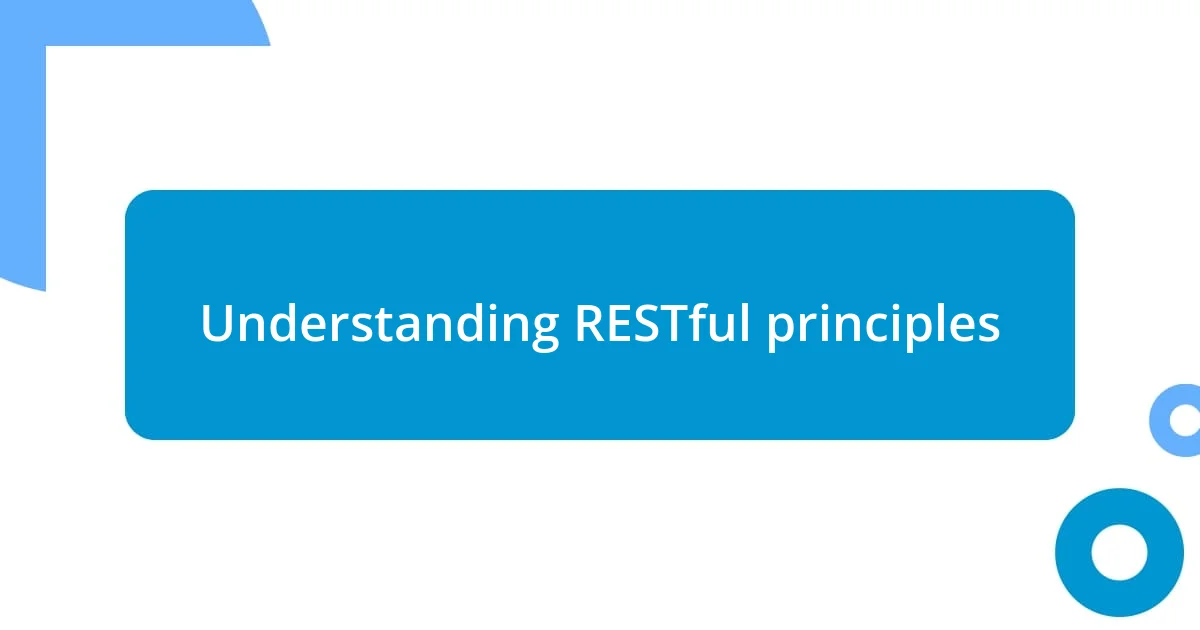
Understanding RESTful principles
When I first encountered RESTful principles, it felt like opening the door to a new way of thinking about web services. The idea that resources are identified and accessed using URLs was a lightbulb moment for me; it provided clarity in how data is organized and retrieved. Have you ever had that kind of epiphany while learning? It’s exhilarating.
One principle that resonates with me is statelessness. Each request from a client must contain all the information needed for the server to fulfill that request. I remember grappling with this idea during a project where managing state was becoming cumbersome. By adhering to stateless communication, I streamlined our interactions and reduced server load, which was a huge relief.
Another critical aspect is the uniform interface, which simplifies and decouples the architecture. Reflecting on my experiences, I’ve learned that when developers adhere to a consistent convention, it fosters collaboration and reduces confusion. Have you ever worked in a chaotic development environment? Trust me, sticking to RESTful principles can significantly enhance team dynamics and project success.
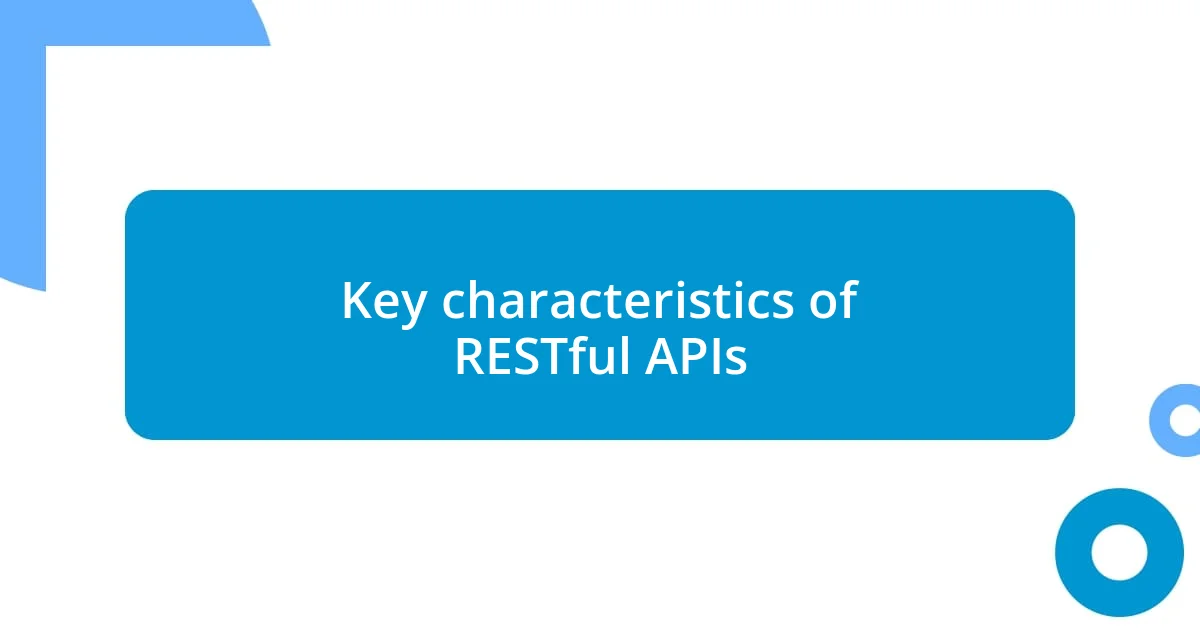
Key characteristics of RESTful APIs
One characteristic that stands out to me is the use of resource-based identifiers. Every resource in a RESTful API is represented by a unique URL, which I found incredibly liberating. In a recent project, I created a simple inventory management system where each product had its own identifiable link. It made data retrieval intuitive and allowed my team to communicate more effectively, as everyone knew exactly where to find the information they needed.
When I delve into the key attributes of RESTful APIs, several essential features come to mind:
- Statelessness: Each request to the server is independent and contains all necessary information.
- Cacheability: Responses must implicitly or explicitly state if they are cacheable, helping to improve performance.
- Layered System: REST APIs can be structured in layers, promoting scalability by abstracting complexities.
- Code on Demand: Servers can provide executable code to clients when necessary, enhancing flexibility.
- Client-Server Architecture: This promotes separation of concerns, allowing clients and servers to evolve independently.
I vividly recall integrating caching mechanisms into my APIs. It not only improved response times but also reduced server strain, which turned out to be a game-changer for our application’s performance. Engaging with these principles not only streamlined my workflows but also deepened my appreciation for the design philosophy behind RESTful systems.
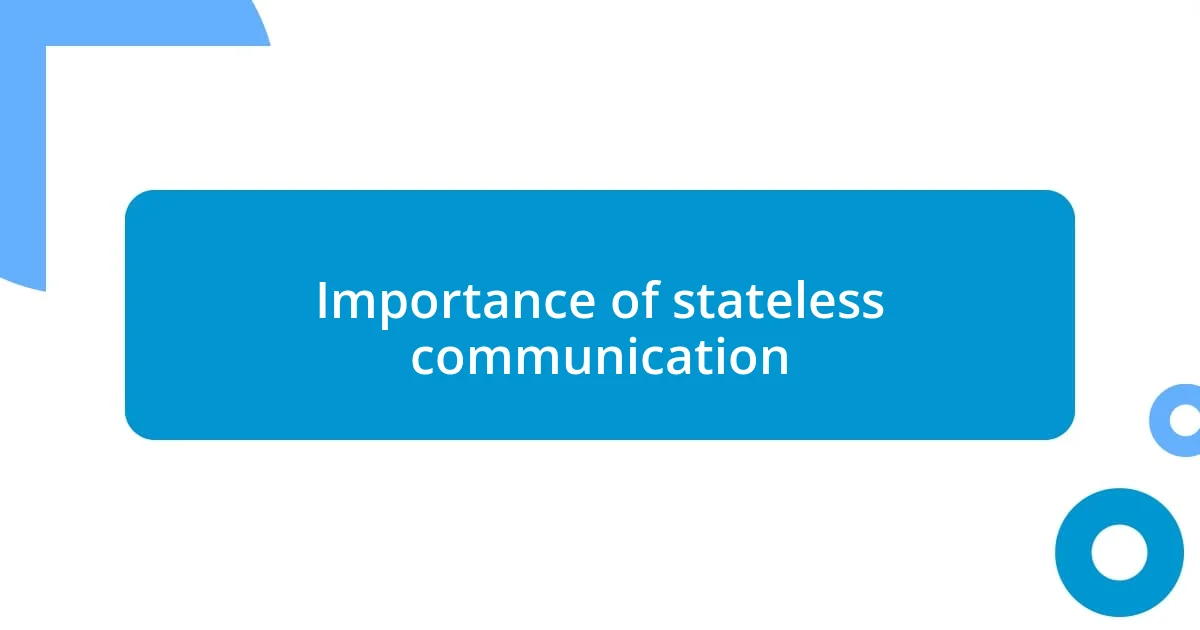
Importance of stateless communication
The significance of stateless communication in RESTful principles truly became apparent to me during my development journey. Imagine building a web application where every single request from the client to the server is completely independent. This not only means that the server doesn’t retain client information between requests but also allows for scalability. I recall the satisfaction I felt when a complex feature I was implementing suddenly became clearer and more manageable just by ensuring that each request carried all necessary data. It prohibited the chaos of maintaining state, which can often bog down performance.
In practice, statelessness fosters improved efficiency in web applications. When each request contains all relevant information, it simplifies debugging. I once spent hours troubleshooting a stateful system where I had to trace back user sessions and interactions. By switching my approach to a stateless architecture, I not only saved time but also saw a notable boost in my application’s responsiveness. It was as if a weight had been lifted; I could finally focus on delivering value rather than managing complexity.
I’ve also realized that the beauty of stateless communication enhances reliability. Since there’s no session data hanging around on the server, it minimizes the chances of errors creeping in. One time, my team encountered frustrating bugs linked to session timeouts during a critical demo. That experience was a wake-up call for me, reinforcing the value of stateless APIs. Ultimately, the clarity and strength that come from statelessness can help developers like us build more robust applications.
| Feature | Stateful Communication | Stateless Communication |
|---|---|---|
| Data Retention | Requires server to retain client data | No server data retention between requests |
| Scalability | Challenging due to state management | Highly scalable as requests are independent |
| Debugging | Complex due to session state | Simpler, as each request is standalone |
| Error Management | Higher risk of session-related bugs | Lower risk; no state means fewer bugs |
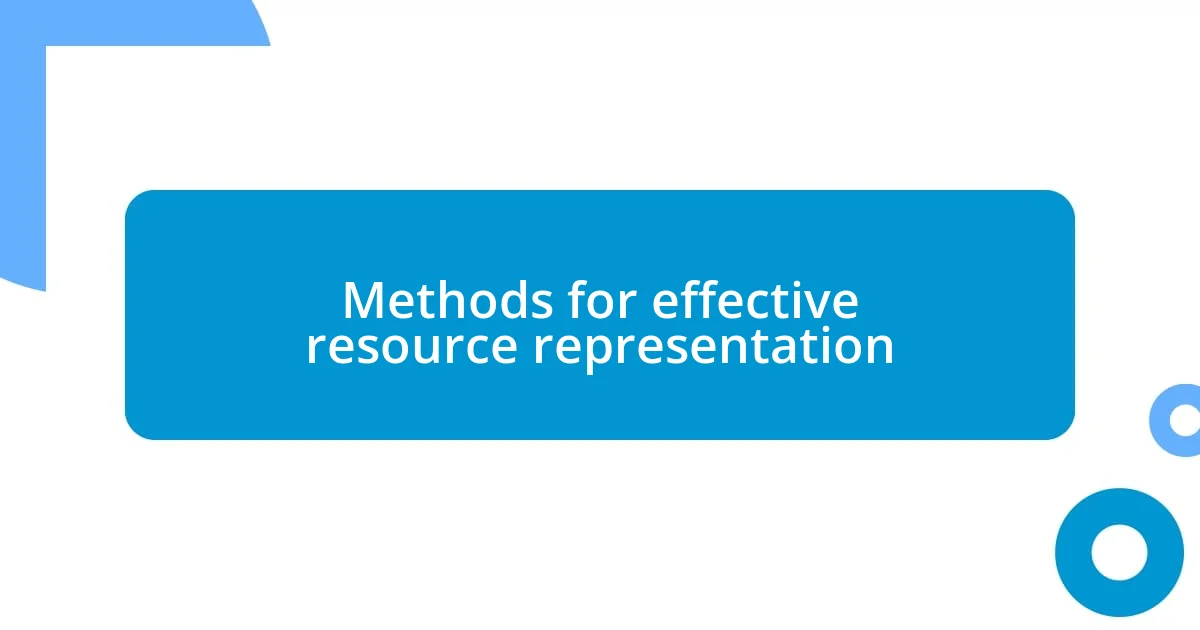
Methods for effective resource representation
When I first tackled resource representation in RESTful APIs, I quickly understood how crucial it is to choose the right format. For instance, using JSON (JavaScript Object Notation) not only made data easily readable for both clients and servers, but it also allowed for seamless integration with various programming languages. Have you ever tried to decode XML after a long day? It can be a real headache! The clarity of JSON was a breath of fresh air—I recall feeling a surge of relief when I realized all my team members could easily parse the data without any confusion.
I also learned the importance of hypermedia as a constraint of REST. By including links to related resources within the responses, I was able to create a more navigable experience for users. It felt like giving them a roadmap to follow rather than leaving them wandering in the dark. One time, after implementing hypermedia controls in a project, I received feedback that my users found it much easier to explore the API, and that brought me genuine joy. Have you ever had someone praise your work in a way that made you feel proud? That’s how it felt!
Moreover, consistent and meaningful naming conventions for resources turned out to be a vital component. When I optimized my API with clear, descriptive names, I noticed a significant drop in support requests. I can still recall that moment of triumph when a user told me how intuitive it was to navigate the system. It made me realize that effective communication is a two-way street; by carefully defining resources, we not only serve information but also foster an environment of understanding and ease for those who engage with our APIs.
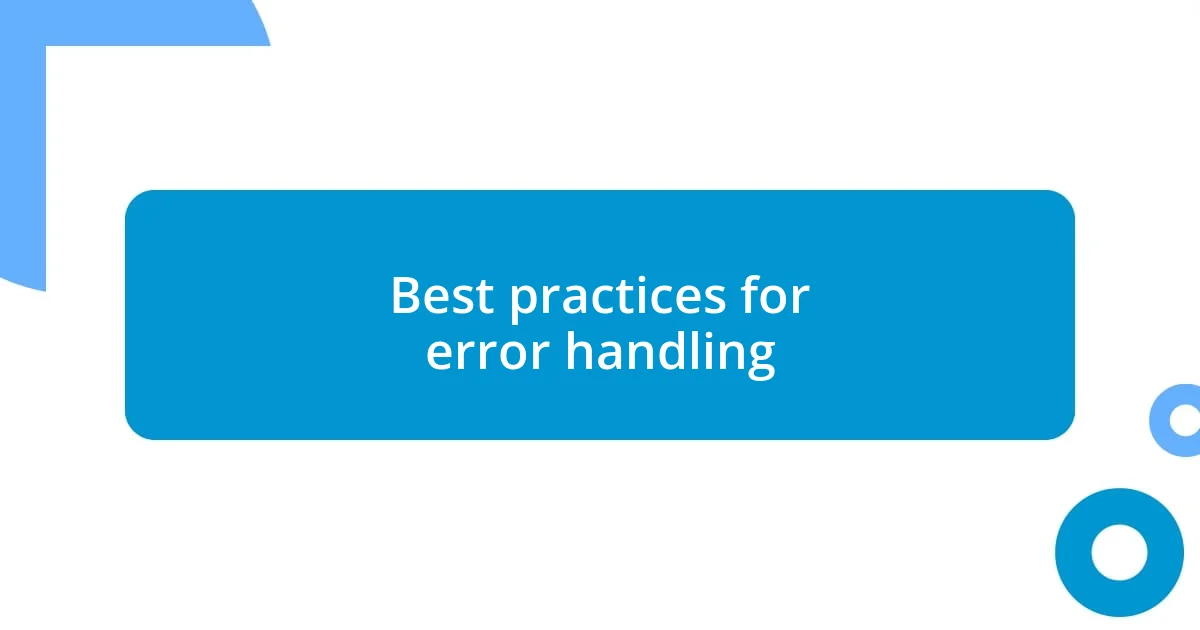
Best practices for error handling
When it comes to error handling in RESTful APIs, clarity is crucial. I learned early on that clear and concise error messages can transform the user experience. For example, rather than just saying “Error 404,” I started providing detailed messages like “Resource not found: The requested user ID does not exist.” This change not only reduced confusion but also made debugging a lot easier for my team. Have you ever faced a baffling error message? It’s frustrating, isn’t it?
Additionally, I always recommend using the appropriate HTTP status codes. Initially, I had a habit of returning a generic 500 Internal Server Error for various issues. However, once I began using relevant codes—like 403 for forbidden access or 400 for bad requests—I saw an improvement in both developer efficiency and user feedback. A well-informed user can take the right action, rather than being left in the dark, which saves everyone time and frustration.
Logging errors meticulously is another essential practice I learned the hard way. I’ve spent countless hours sifting through logs trying to pinpoint issues that could have been caught earlier. Now, I ensure my error logs include timestamps, user IDs, and stack traces. This seemingly small detail allows for swift troubleshooting and often means the difference between a quick fix and a protracted downtime. What have you experienced in your error management processes? Keeping logs organized can truly be a game-changer!
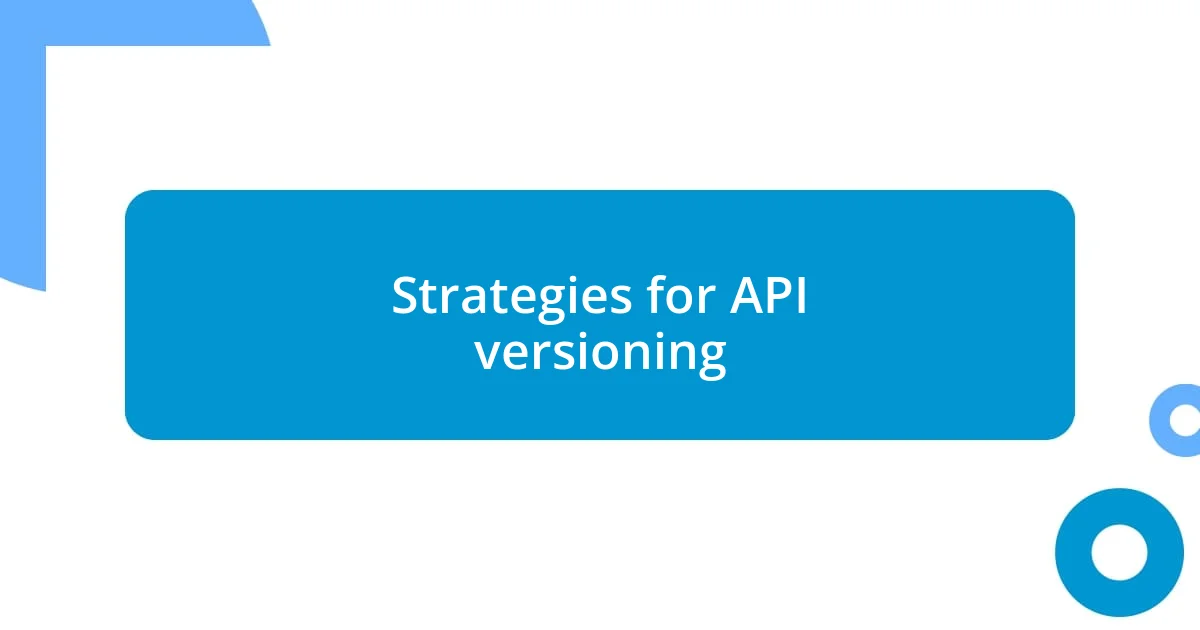
Strategies for API versioning
When it comes to API versioning, one strategy I’ve found particularly effective is the inclusion of the version number in the URL. This approach not only makes it easy for users to understand which version they are working with but also simplifies the management of multiple versions. I’ll never forget how a simple change in the URL structure of one of my earlier projects helped developers quickly adopt new features without disrupting their existing applications. Hasn’t it been a relief when a straightforward solution solves a complex problem?
Another useful strategy is to use request headers to specify the API version. Initially, I was skeptical about moving away from the more visible URL versions. However, I discovered that this method allows for a cleaner API endpoint while enabling backward compatibility with clients that might not be ready to transition. I remember one project where this flexibility became the key to onboarding legacy systems—we could introduce breaking changes with minimal disruption, and it felt like taking a heavy load off everyone’s shoulders.
I also advocate for a staged rollout of new versions. This means releasing the new API version while still prominently supporting the older one for a defined period. I once worked on a project where we introduced new functionality gradually. It was astonishing to witness how user feedback during this transitional phase led to improvements we hadn’t anticipated. Have you ever experienced a transformation driven by listening closely to your users? That’s the power of allowing gradual migration—it can turn potential confusion into an opportunity for growth and enhancement.
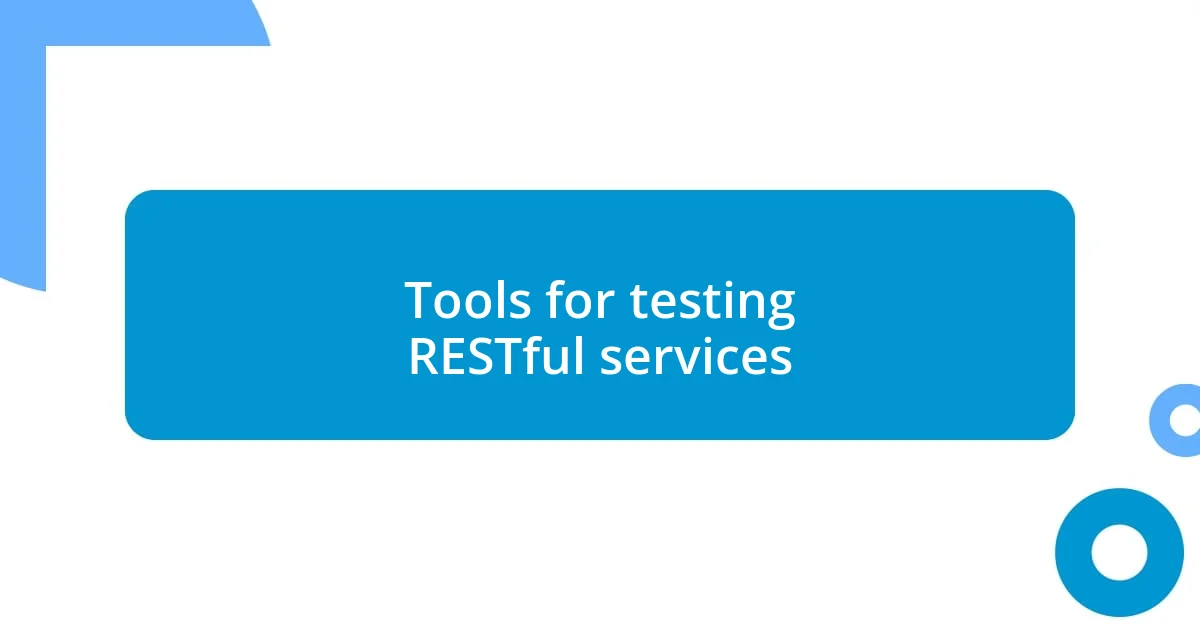
Tools for testing RESTful services
When it comes to testing RESTful services, I’ve found Postman to be an invaluable tool in my workflow. In my early days as a developer, I spent hours debugging issues that could have been easily identified with a few clicks in Postman. Actually, I remember the relief I felt the first time I successfully formulated a request, received the response, and pinpointed the error right on the spot—it opened my eyes to the power of intuitive tools.
Another resource I’ve come to rely on is Insomnia. Initially, I was hesitant to switch from Postman, but Insomnia’s user-friendly interface won me over. The ease of managing environments and organizing requests made my testing process so much smoother. I had an instance recently where I was working on a complex API integration, and being able to visually track my requests felt like having a clear map in a dense forest. Have you ever experienced the clarity that comes from using the right tool? It can be a game-changer.
For performance and load testing, I’ve found Apache JMeter to be quite effective. In a project where my team was preparing for a major release, we used JMeter to simulate user traffic and identify bottlenecks in our API. The insight we gained was crucial—it helped us optimize our service ahead of time and avoid a potential disaster during launch. Looking back, it’s fascinating how a simple tool can not only prevent hiccups in production but also boost team confidence. What about you—how have you leveraged specific tools to enhance your testing processes?














